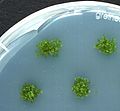Petri dish facts for kids
A Petri dish is a small, round, flat container that looks a bit like a shallow bowl with a lid. Scientists use these special dishes to grow tiny living things like cells from animals, fungus, and even disease-causing germs. This helps them study how these tiny organisms grow and behave.
Contents
What is a Petri Dish?
A Petri dish is a simple but very important tool in science. It is shaped like a cylinder that is wider than it is tall. Think of it like a very flat, round jar. It always comes with a lid that fits snugly over the top.
What are Petri Dishes Made Of?
Petri dishes are usually made from two main materials:
- Glass: These dishes can be used many times. Scientists clean them and then heat them to a very high temperature, about 160 degrees F, to kill any germs. This makes them safe to use again.
- Plastic: These are often used once and then thrown away. They are very common in labs and schools because they are cheap and easy to use.
Why Do Scientists Use Them?
Scientists use Petri dishes to grow and study tiny living things that are too small to see with just your eyes. These include:
- Cells: They can grow animal cells to learn how they work.
- Fungi: They might grow molds or yeasts to study them.
- Bacteria and Germs: They can grow different types of bacteria or other germs to understand how they cause diseases. This helps them find new medicines.
Many students also use Petri dishes in science classes at school. They are great for hands-on experiments.
What is Agar?
Sometimes, Petri dishes are filled with a special jelly-like substance called agar. Agar is made from seaweed. It has nutrients that help tiny living things grow. When a Petri dish has agar in it, it is often called an agar plate. This is like a perfect meal for the cells or bacteria scientists want to grow.
Keeping Experiments Clean
Petri dishes have lids for a very important reason. The lids help keep out unwanted germs or dust from the air. If these get into the dish, they can contaminate the experiment. This means they can ruin the results by growing things that are not supposed to be there. Keeping the dish closed helps make sure only the things scientists want to study will grow.
Images for kids
-
A Petri dish with bacterial colonies on an agar-based growth medium
-
Axenic Cell culture of the plant Physcomitrella patens on an agarplate in a Petri dish
See also
 In Spanish: Placa de Petri para niños
In Spanish: Placa de Petri para niños





